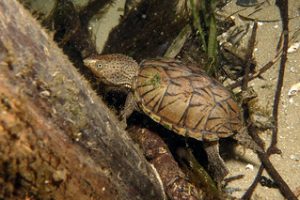As with mud turtles, full grown musk turtles are no bigger than your hand. They differ from mud turtles in that they have a single hinge on their plastron and the scutes just above that hinge are rectangular instead of triangular. Like mud turtles, they are very aquatic and not seen basking or out of water at anytime other than to lay eggs. Also like mud turtles, few people know they exist.
There are only two species in Florida, the Loggerhead Musk (Sternotherus minor) and the Common Musk (Sternotherus odoratus). There is a subspecies of the Loggerhead Musk in the far western panhandle, the striped-necked (Sternotherus minor peltifer).
The Loggerhead Musk is found through much of the southeastern United States and much of Florida. Like all musk and mud turtles it is small, with an average carapace length of 6 inches. The carapace will have 3 keels and small black flecks scattered across the light brown/olive colored shell. The head is large and wide with large jaws for crushing mollusk shells, a favorte food. The head is light colored with dark markings and 2 barbels (fleshy whiskers) under the chin. These barbels are chemosynthetic and help locate food. There are no striped on the head.
They prefer to walk across the bottom of either calm or flowing waterways, rarely leaving the water and have been found as deep as 44 feet into springs. In the waterways where they are found they have some of the highest densities of any turtle in the area – as much as 3000 individuals in a hectare. They breed in both fall and spring and the female usually does not travel far from the water to lay her eggs. Eggs have been found near logs and stumps. She will usually lay about 1-5 and they may take 100 days to incubate. Loggerheads feed on insects when young and switch to mollusk as adults. They have been known to eat other small turtles in captivity. They are preyed upon by alligator snapping turtles and maybe the alligator itself. They have been popular in the pet trade.

This common musk turtle (stinkpot) shows the dark head with stripes but also shows at bullet hole from a practice by some people called “plinking”. Where they practice shooting at turtles.
The Common Musk turtle is just that… common. It is found across the entire eastern portion of the United States and all of Florida. As its scientific name suggests (S. odoratus) it releases a pungent musk from glands near the bridge between the carapace and the plastron. This strong musk gives the turtle is other common name “Stinkpot”.
It too has a carapace about 6 inches long but differs from the Loggerhead in that its head is dark with 2 Yellow-White stripes running laterally. There is also a notch in the plastron near the tail. It is very aquatic, and can be found in high densities, but prefers still quite waters. They are known to be deep divers as well, diving to depths of 30 feet.
They will nest more inland than Loggerheads and usually lay multiple clutches of 1-9 eggs sometimes not burying them. Stinkpots are omnivorous, preferring mollusk but will also consume other invertebrates and seeds. Being small, they are preyed upon by raccoons, wading birds, fox, skunks, water snakes, hawks, eagles, alligators, snapping turtles, bull frogs, and even large mouth bass.
The handling of small turtles must be done with care. They have a long reach and nasty bite. But they are very cool turtles and very common. It is very cool to see them while snorkeling or paddling our rivers and springs.
Resource:
Meylan, P.A. (Ed.). 2005. Biology and Conservation of Florida Turtles. Chelonian Research Monographs No. 3, 376 pp.
- Rattlesnakes on Our Barrier Islands; Part 4 – Thermoregulation - December 29, 2025
- Rattlesnakes on Our Barrier Islands; Part 3 – Envenomation - December 22, 2025
- St. Joe Red Tide Claiming Terrapins - December 15, 2025

